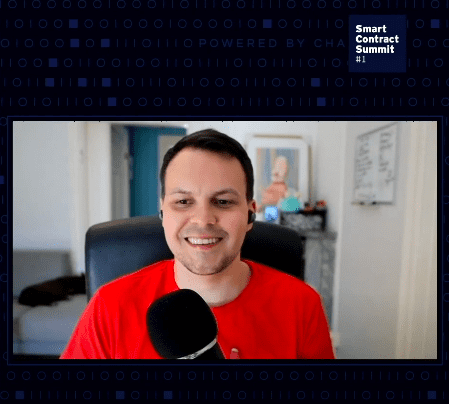One of the most anticipated speakers at SmartCon #1 was Aleksander Leonard Larsen, Co-Founder and COO of Sky Mavis, the creator of Axie Infinity. By the time Larsen joined Cointelegraph journalist Andrew Thurman to discuss “Going from Zero to One with Axie Infinity” on the morning of SmartCon Day One, Axie had already received numerous nods from speakers on other panels.
“Axie is on an unbelievable run right now,” Thurman said, calling Axie Infinity “comfortably the most successful NFT game,” with daily active users approaching one million and Ronin becoming the most active Ethereum sidechain for NFTs. Impressive as Axie’s growth has been over the past twelve months, Larson said, “From our point of view, it’s just getting started.”
Crypto For The Masses
Since Axie was founded in 2018, Larson said he’s seen a “massive opportunity” to introduce crypto to the mainstream through games. Initially, the team had no idea how long mainstream adoption would take. “When we got started, there wasn’t even DeFi,” he told Thurman.
More Than Just A Game
Thurman emphasized how Axie’s surrounding ecosystem – a massive Twitter community, numerous full-time Twitch streamers, a collection of podcasts and an ocean of art and memes – seems to be growing as fast as the game itself. Larson said Axie Infinity is not just a game, but the combination of a game, a community and an economy.
The Promise Of NFTs
Axie’s in-game NFT assets were created to provide the most utility for inhabitants of Lunacia, Axie’s player-owned and controlled virtual realm. But the beauty of NFTs is that users will ultimately be able to take their NFTs with them wherever they go in the digital world. And while Larson said Axie is still focused on its core development, he pointed toward a sea of cross-chain collaboration on the horizon.
“We are maybe only at 15% when it comes to the development of Axie Infinity and how this game can evolve over time,” he said. “It’s natural that people should be able to use their Axies in other games as well. They are NFTs; they should be open. So that’s definitely coming.”
A Permissionless Metaverse
Thurman seized the opportunity to distinguish between the concept of one permissionless metaverse and the model of many metaverses, the latter seeming “fundamentally antithetical” to the notion of a single metaverse “that’s fully interoperable across multiple game worlds and can overcome licensing and IP barriers.”
Larson said he’s of the opinion that big tech companies will likely try to “co-opt” the term “metaverse” to compete with each other’s walled garden. But the metaverse is fundamentally defined as a space where people – not companies – actually own digital objects that retain value and utility across different games and applications.
Larson doesn’t see big tech’s efforts panning out. “I’m not so worried that they will succeed,” he said – especially since player-owned economies like Axie, where users truly own their digital assets, are already thriving.
“Once the genie is out of the bottle, it’s really hard to put it back. So they might try it but I don’t think it’s gonna happen.”
Watch the full SmartCon Q&A with Aleksander Leonard Larsen and Andrew Thurman.
Explore other presentations from Smart Contract Summit #1’s playlist.
Elizabeth Licorish is a writer and author whose work has appeared in HuffPost, PhillyVoice and Bustle. In 2008, she wrote and co-authored Innovation for Underdogs. In 2010, she wrote and edited Charles Manson Now. She received her MFA in creative nonfiction from Rutgers University and has ghostwritten hundreds of executive thought leadership pieces for some of the world’s leading experts across diverse industries. She has been writing and editing for influential blockchain projects since 2017, when she fell in love with decentralized finance’s potential to empower individuals in an economically just world. As the editor-in-chief of Chainlink Today, she’s passionate about telling the human stories behind some of the most promising technology in the fastest-growing blockchain ecosystem.


